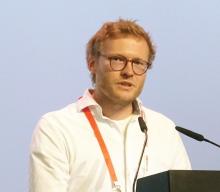BERLIN – Escalating treatment to a “highly effective” disease-modifying treatment (DMT) results in fewer relapses in patients with relapsing-remitting multiple sclerosis (RRMS) than does switching to another “moderately effective” therapy, according to data from a Danish cohort study.
The annualized relapse rate (ARR) was 0.23 for patients who switched to a highly effective DMT, defined as either natalizumab (Tysabri) or fingolimod (Gilenya), whereas the ARR was 0.35 in those who were switched to a moderately effective DMT, defined as an interferon-beta, glatiramer acetate (Copaxone), teriflunomide (Aubagio), or dimethyl fumarate (Tecfidera).
This resulted in a relapse-rate ratio of 0.67 (95% confidence interval [CI], 0.55-0.83) comparing high to moderate DMT, or a 33% lower relapse rate in the high DMT group, Thor Ameri Chalmer, MD, PhD, reported at the annual congress of the European Committee for Treatment and Research in Multiple Sclerosis.
Dr. Chalmer, who works at the Danish Multiple Sclerosis Center at Rigshospitalet, the University of Copenhagen, reported that the time to first relapse and the likelihood for having recurrent relapses were all lowered by escalating treatment rather than switching treatment. Indeed, there was a 38% increase in the time to first relapse (hazard ratio [HR] = 0.62; 95% CI, 0.50-0.76) and a 31% reduction in recurrent relapses (HR = 0.69; 95% CI, 0.57-0.83).
However, there were “no clear differences” in the time to 3-month confirmed Expanded Disability Status Scale (EDSS) worsening and improvement, Dr. Chalmer said. The HR for time to first worsening in the 3-month confirmed EDSS was 0.86, and for recurrent worsening it was 0.86, but the 95% CI in both cases crossed over from 1.0 (0.65-1.14 and 0.71-1.05, respectively). There was no difference in the time to first improvement (HR = 1.23; 95% CI, 0.95-1.60).
“The aim of this study was to use data from the [Danish] MS Registry, find the patients who started on what we define as moderately effective DMT for the first time, and on this treatment experienced a disease breakthrough and then either switched to another moderately effective DMT or escalated to a highly effective DMT,” Dr. Chalmer explained.
Disease breakthrough was defined as at least one relapse occurring within 12 months of the treatment switch, or the treating neurologist defined the reason for switching as disease breakthrough. Dr. Chalmer acknowledged that this was one of the limitations of the observational study as patients could have been misclassified and switched treatment for another reason. The severity of the relapse was not recorded.
Data on more than 5,000 patients enrolled in the Danish Multiple Sclerosis Registry (DMSR) were considered, with a final propensity-match population of 788 included in the analysis; half had received highly effective DMT and half moderately effective DMT.
The DMSR contains data on virtually all patients with MS treated in Denmark, Dr. Chalmer observed; treatment with DMT is free of charge and it can be prescribed only in public MS clinics, he explained. Furthermore, all MS clinics are required to register information about treatment response at each clinical visit.
The mean age of patients in the study was 39 years, around 70% were female, and average disease duration was 5 years.
“I don’t see in your study what is really new,” Gilles Edan, MD, observed during a discussion. “We know that using more active, more efficient drugs gives more control on relapse.”
Dr. Edan, professor and head of the neurosciences department of University Hospital Pontchaillou, Rennes (France), added that these data “confirmed what has already been observed in the clinical trials.”
It is important to consider the safety and efficacy concerns on an individual level, Dr. Edan argued, questioning whether the more highly active drugs should be systematically used first-line rather than second-line in all patients with MS. He also noted that of course patients would need to be treated for very long periods.
Dr. Chalmer responded: “I agree some of the randomized trials have touched upon on this as well, but I think it’s really important to not just rely on one or two trials but to keep on doing the trials over and over again so that we show that we have the right results.”
Dr. Chalmer added that the present study looked only at efficacy and that the median follow-up time was 3.2 years. “Safety is important of course, but it was not the aim of this study.” Perhaps longer follow-up might have detected more differences in the EDSS outcomes, he added.
The study was funded by the Danish Multiple Sclerosis Society, the Foundation for Research in Neurology, Ejnar Jonassen, and Gangstedfonden. Dr. Chalmer disclosed he had received support for congress participation from Merck, Biogen, and Roche.
SOURCE: Chalmer T et al. Mult Scler. 2018;24(S2):99. Abstract 263.


